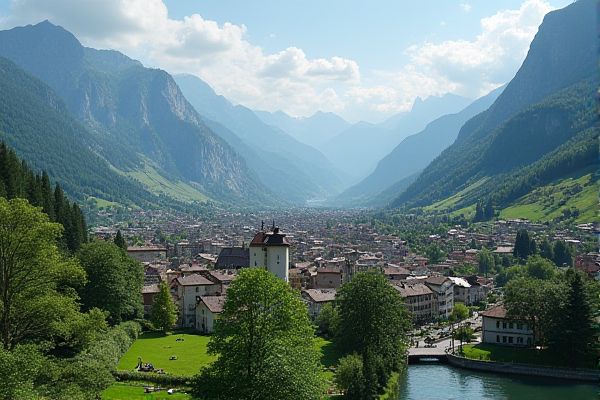
Weather and climate in Switzerland: Four distinct seasons. High-altitude Alpine climate. Mild climate in Central Plateau. Rainiest months: May and June. Snowfall in higher elevations. Summer temperatures: 18-28degC. Winter temperatures: -2 to 7degC. Microclimates in different regions. Sunny days in autumn. Fog common in lowlands.
Four distinct seasons.
Switzerland experiences four distinct seasons, with a continental climate characterized by cold winters and pleasant but variable summers. The winter months, January and February, see temperatures ranging from -2°C to 7°C. In contrast, summer, which stretches from June to September, offers a more favorable climate with temperatures varying between 18°C and 28°C. The country enjoys moderate temperatures during the transitional seasons of spring and autumn. Spring, occurring from mid-March to mid-June, averages temperatures from 8°C to 15°C, while autumn sees a gradual drop in temperature. For more detailed information on the climate patterns and seasonal variations, visit the Switzerland Climate page.
High-altitude Alpine climate.
The Swiss Alps experience a highly varied climate, divided into five distinct zones based on elevation: the Neve zone (above 3,000m), the alpine zone (2,000-3,000m), the subalpine zone, the arable zone, and the lowlands. Temperatures drop significantly with altitude, with daytime temperatures in winter averaging around 25°F (-7°C) and in summer between 46°F and 52°F (8°C and 11°C) in areas like St Moritz.
Mild climate in Central Plateau.
The Central Plateau (Mittelland) in Switzerland has a moderately continental climate, characterized by cold winters with freezing temperatures in January and warm summers with highs around 25°C. This region, home to major cities like Zurich, Lausanne, and Geneva, experiences significant climatic influences from winds such as the Bise and the Alpine Foehn, leading to varied weather conditions throughout the year. For those considering relocating or visiting, understanding the Switzerland Climate is essential to prepare for the unique blend of weather patterns that this picturesque country offers.
Rainiest months: May and June.
The rainiest months in Switzerland are May and June, with the rainy season extending from May to August. June is particularly noted as the wettest month, making these periods ideal for indoor activities such as visiting museums, swimming pools, and thermal baths. For more detailed insights on planning your trip, check out the Best Time to Visit in Switzerland guide on Flamingo Travels' website.
Snowfall in higher elevations.
In Switzerland, snowfall at higher elevations is significant and consistent, with places like Davos, Scuol, and Samedan, all above 1,500 meters, receiving substantial snowfall annually. For example, the Santis mountain peak at 2,502 meters receives an average of 1,114 cm of snow over 123 days each year. For more detailed insights on the climate in this region, you can visit the comprehensive guide on Switzerland Climate, which provides further information on weather patterns and seasonal variations across the country.
Summer temperatures: 18-28°C.
In Switzerland during the summer, temperatures generally range from 18°C to 28°C with mild and warm conditions, especially in lower-lying areas like Geneva and Zurich. However, higher altitudes remain cooler and can be wetter. For more information on the seasonal variances and other weather-related details, you can visit the Switzerland Climate page on Expatica.
Winter temperatures: -2 to 7°C.
Winter temperatures in Switzerland generally range from -2°C to 7°C, with significant variations depending on altitude and location. During this season, the days are characterized by only a few hours of sunlight, creating a unique atmosphere for both residents and visitors. For those planning a move or visit, understanding the Switzerland Climate can be vital in preparing for the cold and appreciating the stunning winter landscapes that this country offers. The climate can significantly influence daily activities and overall lifestyle, especially in areas situated at higher elevations.
Microclimates in different regions.
Switzerland is characterized by diverse microclimates due to its varied topography, with the Alps, Central Plateau, and Ticino each having distinct climate profiles. The [Alps](https://www.expatica.com/ch/moving/about/switzerland-climate-203428) create a significant climatic barrier, resulting in colder temperatures with increasing altitude, while the Central Plateau has a moderately continental climate, and Ticino enjoys a nearly Mediterranean climate with warmer temperatures.
Sunny days in autumn.
In Switzerland during autumn, September stands out as the sunniest month with 9 hours of daylight, offering the best time for sunny days. As the season progresses, the hours of daylight decrease, with October and November seeing reductions to 8 and 6 hours, respectively. This transition makes Switzerland a unique place to experience the change in seasons, as the vibrant autumn light gradually dims, setting the stage for the winter months.
Fog common in lowlands.
Fog and low stratus are common in the Swiss Plateau during autumn and winter due to stable high-pressure conditions, cold air accumulation, and temperature inversions. These conditions lead to prolonged periods of fog in the lowlands. For more information on this atmospheric phenomenon, visit the detailed section about the Swiss Plateau Fog Hole on the MeteoSwiss website.
